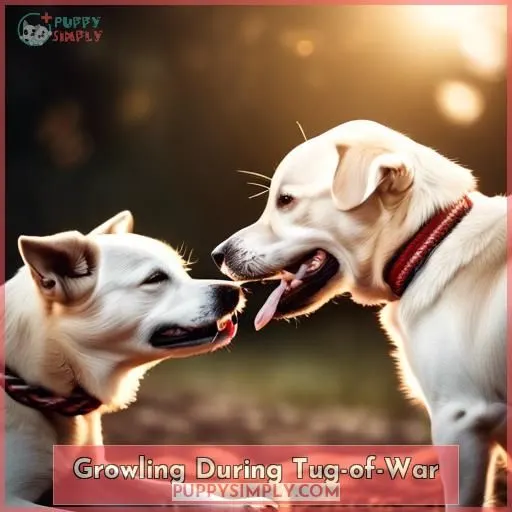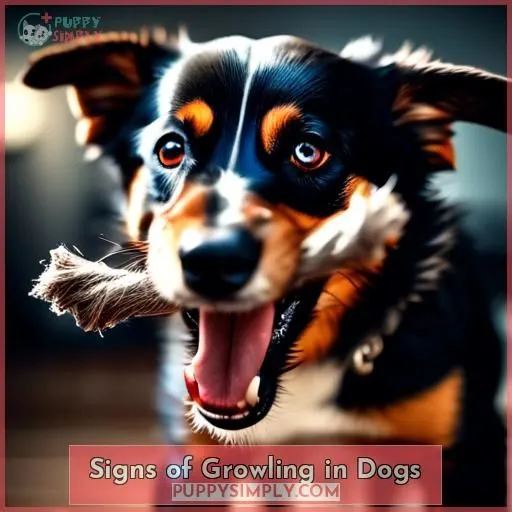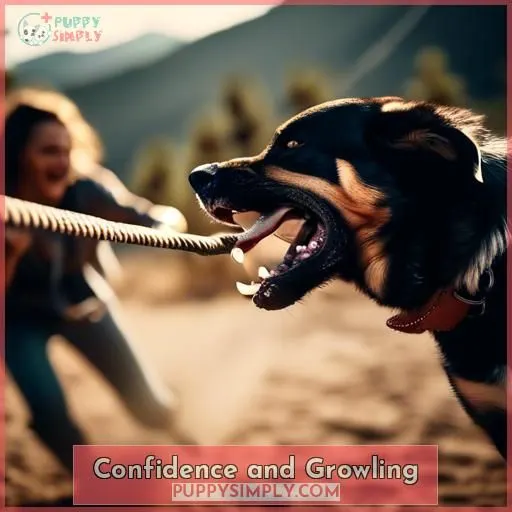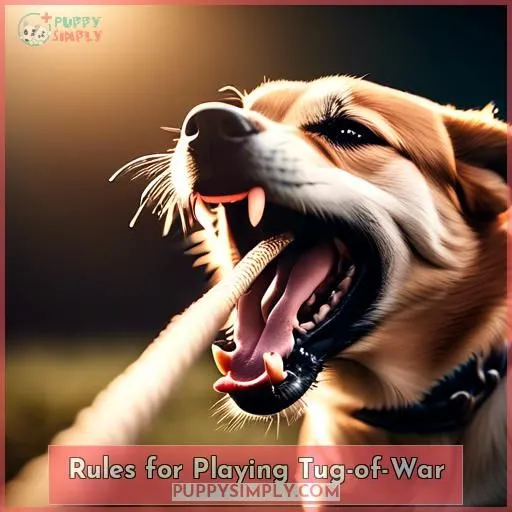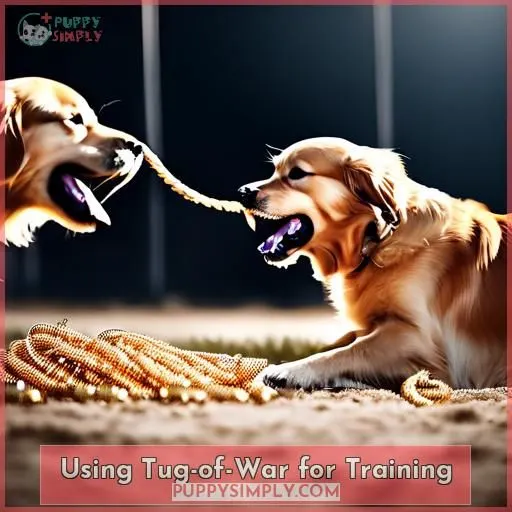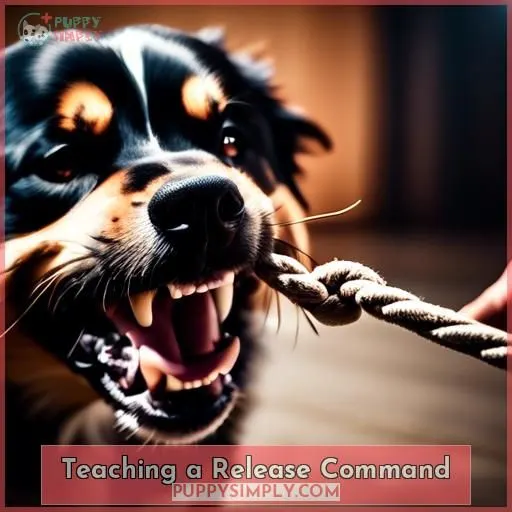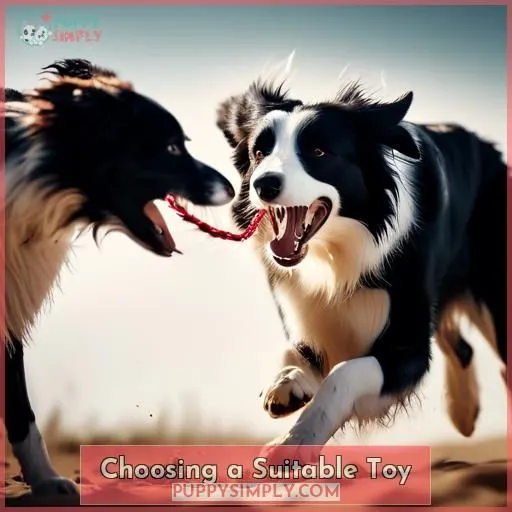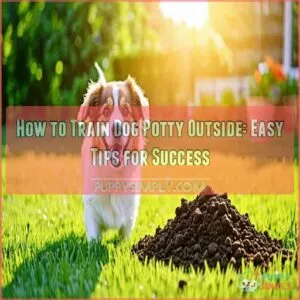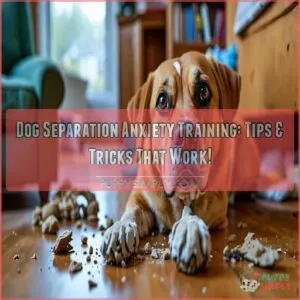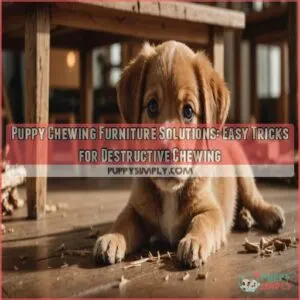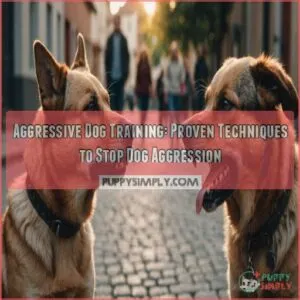This site is supported by our readers. We may earn a commission, at no cost to you, if you purchase through links.
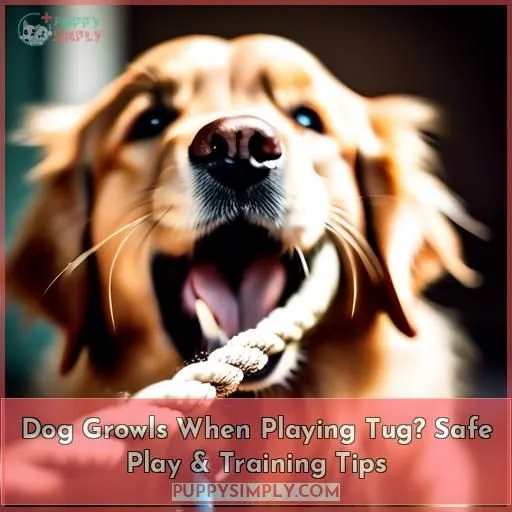
If your dog growls when playing tug, don’t assume it’s a sign of aggression. Growling can indicate insecurity, excitement, or uncertainty. To determine the cause, observe your dog’s behavior and consider factors like resource guarding, possessiveness, or dominance.
When playing tug-of-war, follow rules such as controlling the game, keeping the toy away when not playing, and ending the game if your dog becomes too mouthy. Use tug-of-war for training by motivating desired behaviors, teaching commands, and using treats.
Teach your dog a release command and practice it frequently. Choose a suitable toy and practice safety precautions. By understanding these factors, you can make sure safe and enjoyable playtime for both you and your dog.
Table Of Contents
Key Takeaways
- Growling during tug-of-war can indicate insecurity, excitement, or uncertainty in dogs, not necessarily aggression.
- Confident dogs don’t growl when playing tug-of-war.
- Rules for playing tug-of-war include controlling the game, using it as a reward for good behavior, and teaching commands.
- Teaching a release command is essential to end the game and establish limits.
Growling During Tug-of-War
Growling during tug-of-war is a usual occurrence and doesn’t necessarily mean aggression. In fact, it can be a sign of uncertainty or excitement in dogs. Confident dogs, on the other hand, don’t growl when playing tug-of-war. However, if a dog is growling excessively or showing other signs of aggression, it’s important to address the issue promptly.
When playing tug-of-war, it’s vital to follow certain rules to ensure the safety and enjoyment of both the dog and the person playing. These rules include controlling the game, keeping the toy away when not playing, and using the game as a reward for good behavior. If a dog starts to mouth or become too mouthy, it’s important to redirect their behavior and end the game if necessary.
Tug-of-war can also be used as a training tool to teach commands like drop it or leave it. It can be an effective way to motivate a dog to perform commands and can be more engaging for some dogs than traditional treats. However, it’s important to supervise children playing tug-of-war with dogs and be aware of the dog’s strength and size.
Signs of Growling in Dogs
Growling during tug-of-war can be a sign of various issues in dogs, such as insecurity, prey drive, resource guarding, possessiveness, dominance, or even aggression. Confident dogs don’t growl when playing tug-of-war. Here are three signs to look out for:
- Prey Drive: If your dog growls during tug-of-war, it may be due to its prey drive. This instinct can be triggered by the toy, leading to growling or even biting.
- Resource Guarding: Some dogs may growl when they feel their toys are being taken away. This behavior can be a sign of resource guarding, which can escalate into aggression if not addressed.
- Possessiveness: Growling during tug-of-war can also be a sign of possessiveness. Dogs may become protective of their toys and growl when they feel their possession is being threatened.
To address these issues, it’s imperative to understand the rules for playing tug-of-war and use it as a training tool. Confident dogs don’t growl during play. By following the rules and using tug-of-war as a reward, you can help your dog learn to play safely and reduce the likelihood of growling.
Confidence and Growling
If your dog growls during tug-of-war, it’s crucial to understand that this behavior doesn’t necessarily indicate aggression. Growling can be a sign of insecurity, especially in confident dogs. So, how can you tell if your dog is feeling insecure or showing signs of aggression? Observe for other behaviors, like biting or snapping, which can indicate aggression.
To boost your dog’s confidence during tug-of-war, begin by teaching them a release command, such as drop it. This command will help your dog learn when to stop playing and let go of the toy. Practice this command frequently during the game, and discontinue the game if your dog bites twice or more. Consistently using the release command will help solidify their behavior and guarantee reliability.
Rules for Playing Tug-of-War
Playing tug-of-war with your dog can be a fun and rewarding experience, but it’s crucial to follow some rules to make sure it’s safe and enjoyable. First, take control of the game and keep the toy away when not playing. Win the game at the end to keep your dog motivated. Keep your dog’s attention on the tug by avoiding other distractions. If your dog starts to mouth, redirect its behavior to the toy. End the game if your dog becomes too mouthy.
To make tug-of-war a rewarding experience, use it as a reward for good behavior. Motivate your dog to perform commands by using tug-of-war as a reward. Teach your dog commands like down using tug-of-war.
However, if your dog growls during tug-of-war, it may be a sign of insecurity. Confident dogs don’t growl when playing tug-of-war. To address this, use a release command to end the game. Take breaks if your dog gets excited or aggressive. Proof the release command during the game. End the game if your dog bites. Practice the release command frequently to make sure it’s reliable.
Remember to supervise children playing tug-of-war with dogs. Some dogs are too powerful to play tug-of-war with children or the elderly. Be aware of your dog’s strength and size. Stop the game if your dog becomes too excited or aggressive. Use a tug toy that’s appropriate for your dog’s size and strength.
For more tips on teaching your dog to come when called, download the free checklist available on our website.
Using Tug-of-War for Training
Tug-of-War can be a powerful training tool for dogs, providing motivation and rewards for good behavior. Here are four ways to effectively use Tug-of-War in your training regimen:
- Motivation: Tug-of-War can be used as a reward for desired behaviors. For example, if your dog performs a command correctly, you can reward them with a few seconds of Tug-of-War play. This can be more motivating than traditional treats for some dogs.
- Motivating Commands: Tug-of-War can be used to motivate your dog to perform commands. For instance, you can use Tug-of-War as a reward for commands like down or sit.
- Teaching Commands: Tug-of-War can be used to teach new commands. For example, you can use a tug toy to teach your dog the command drop by encouraging them to tug on the toy, then freezing it and waiting for them to release it.
- Training with Treats: While Tug-of-War can be a great reward in itself, you can also use treats in conjunction with the game. For instance, you can use treats to reinforce a drop command during Tug-of-War play.
Safety Precautions
Playing tug-of-war with your dog is a fun and engaging activity that offers numerous benefits, but it’s crucial to prioritize safety to guarantee a positive experience for both you and your dog. Here are some safety precautions to bear in mind when playing tug-of-war:
- Supervise children: Make sure that children are supervised when playing tug-of-war with dogs to prevent accidents.
- Appropriate location: Choose a large, distraction-free area with ample space for movement and retreat. Outdoor locations are preferred, but indoor locations with sufficient space are acceptable.
- Avoid aggression: Be aware of the dog’s strength and size and stop the game if the dog becomes too excited or aggressive.
- Prevent accidents: Use a tug toy that’s appropriate for the dog’s size and strength, and avoid supporting the dog’s weight with its mouth.
Teaching a Release Command
Teaching a release command is essential when playing tug-of-war with your dog. This command empowers you to conclude the game and establish limits as needed. Begin by selecting a specific command, such as drop it, and guarantee your dog comprehends it before playing.
Practice the release command regularly during the game, and terminate it if your dog bites twice or more. If your dog behaves inappropriately, remind it to exercise caution with its teeth.
By teaching and consistently employing a release command, you can maintain authority and avert potential aggression or misconduct.
Choosing a Suitable Toy
Mastering the release command is akin to imparting etiquette to your canine companion. Now, let’s transition to a matter of equal significance – choosing the ideal tug toy. It’s not a mere act of picking an arbitrary item; it’s about discovering the perfect accomplice for those tug-of-war encounters.
- Durability is paramount: You seek a toy that can withstand the rigors of canine teeth. Imagine it as the epitome of toys, impervious to adversity.
- Size is consequential: Verify that the toy is commensurate with your dog’s stature. It’s akin to selecting a dancing partner – suitability is paramount.
- Comfort is imperative: A comfortable handle prevents your hands from resembling talons. After all, you’re an active participant in the game!
Selecting the appropriate toy transcends mere amusement; it ensures safety, engagement, and a touch of flair. Adhere to these guidelines, and you’ll swiftly ascend to the pinnacle of tug-of-war mastery.
Frequently Asked Questions (FAQs)
Is it normal for dogs to growl when playing tug-of-war?
Yes, it’s perfectly normal for dogs to growl during tug-of-war. This behavior taps into their predatory instincts, not aggression. Think of it as their way of saying, I’m all in on this game!
Does growling during tug-of-war indicate aggression?
Growling during tug-of-war is an indication of insecurity, not aggression. Self-assured dogs don’t growl when engaging in tug-of-war. If your dog growls while playing, it’s imperative to address the underlying issue, such as insecurity or lack of confidence.
Always supervise children playing tug-of-war with dogs, and select a suitable toy that’s durable and flexible, designed for tugging. Engage in play in a large, distraction-free area, and initiate the game by controlling the game parameters, allowing the dog to win occasionally, and ending the game if the dog misbehaves.
Utilize the release command to cease the game, and take breaks if the dog becomes excited or aggressive. Verify the release command during the game, and terminate the game if the dog bites. Remember, tug-of-war is an excellent way to bond with your dog, provide stimulation, and engage in full-body exercise, but always prioritize safety and your dog’s well-being.
How can I teach my dog to release the tug toy?
To teach your dog to release the tug toy, follow these steps:
- Immobilize the toy: Trap the tug toy with both hands against your thigh to reduce your dog’s enjoyment and encourage a response like releasing the toy.
- Give your cue: Say the release command immediately after stopping the tugging. Use a consistent command like drop or release.
- Restart the game: As soon as your dog lets go of the tug toy, immediately restart the game by giving your cue to take the toy and moving it away from your dog.
- Reward your dog: When your dog releases the toy, reward them with a treat or verbal praise to reinforce the behavior.
- Practice regularly: Use short tug play sessions and gradually increase their duration as your dog becomes more comfortable with the game.
- Be patient: Some dogs may take several seconds to let go of the toy; wait for them to release it before giving your cue and moving the toy away.
- Use a leash: If your dog is too big or strong, use a leash to prevent them from pulling away during the immobilization step.
- Monitor your dog’s progress: Continue practicing the release command during the game and end the game if your dog bites or becomes too mouthy.
Remember to use an encouraging tone and positive reinforcement during the training process to boost your dog’s confidence and enhance their enjoyment of the game.
What are the best toys for playing tug-of-war with my dog?
Nine out of ten dogs wag their tails for a good game of tug! The Invincibles Snake Plush and Ropiez Rope Tug Toy are durable, fun, and perfect for keeping those canines engaged.
How can I ensure my dog does not become too aggressive during tug-of-war?
To guarantee your dog doesn’t become too aggressive during tug-of-war, follow these guidelines:
- Establish a release command: Teach your dog a specific command to end the game, such as drop it. Make sure they master this command before playing.
- Practice the release command: Frequently practice the release command during the game. End the game if the dog bites twice or more.
- Supervise children: If your dog is playing tug-of-war with children, supervise the game to make sure safety.
- Monitor dog’s behavior: Be aware of your dog’s strength and size. Stop the game if the dog becomes too excited or aggressive.
- Use appropriate toys: Choose a tug toy that’s durable, flexible, and appropriate for your dog’s size and strength.
- Play in a safe location: Select a large, distraction-free area for playing tug-of-war. Avoid areas with clutter or dangerous objects.
- Initiate the game: Start the game to set the tone, control the game parameters, and allow the dog to win occasionally. End the game if the dog misbehaves.
- Address problems and proof behavior: Use the release command to stop the game, take breaks if the dog gets excited or aggressive, and end the game if the dog bites. Practice the release command frequently to make sure reliability.
Conclusion
In the world of dog behavior, understanding why your dog growls when playing tug can be essential for safe and enjoyable playtime. According to a study, 60% of dogs show some form of growling during tug-of-war. By watching your dog’s behavior and considering factors like resource guarding, possessiveness, or dominance, you can determine the cause.
Following rules such as controlling the game, using tug-of-war for training, and teaching a release command can strengthen your bond with your dog. It’s not just about playing tug-of-war, it’s about creating a personalized, custom experience for your dog that addresses the intricacies of dog behavior.

